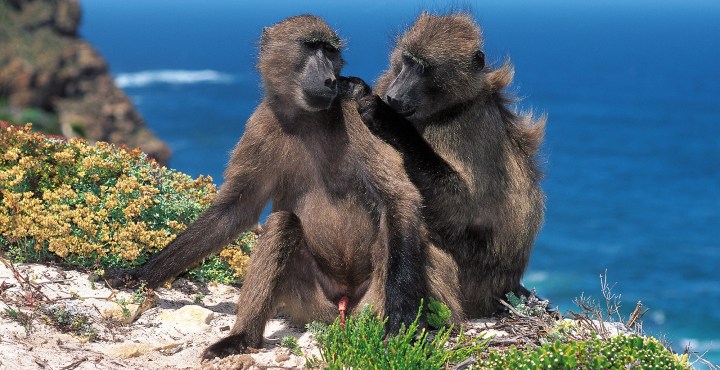OUR BURNING PLANET
We need a different solution to enable baboons and humans to co-exist, not the same old, tired arguments

Perhaps we don’t even need academics any more. Perhaps we need engineers to look at secure waste management, or human psychologists, even professional mediators. What we, the community, need is a system that works.
Pete Oxford is a zoologist, writer, photographer and conservationist. He is a permanent resident of Betty’s Bay working hard to find a practical and manageable solution to the baboon/human issues within the Kogelberg Biosphere Reserve.
It seems Justin O’Riain’s article is once again forcing us to to waste time on yet another rebuttal of the same old tired arguments. I understand the ecology and the reasons why baboon incursions are happening, despite the claimed “careful collective design”.
There is a lot of veiled criticism in the article, particularly of the work of the “activists” to whom he and Shirley Strum refer. Is this helpful? Should we then call the other “side” radicals? Here in Betty’s Bay they certainly call for radical “solutions”. Will our taunts help to provide a way forward?
O’Riain comes well qualified as an academic with PhD students and published papers etc. Remember though that the single greatest driving force of an academic is to get things out in the scientific journals. Have those same papers really helped baboon management? In the main, no, not really. We probably do not need to know the urinary C-Peptide levels in baboon urine.
Perhaps we don’t even need academics any more. Perhaps we need engineers to look at secure waste management, or human psychologists, even professional mediators. What we, the community, need is a system that works. The “anti” baboon lobby, for want of a better word, have got what they wanted from the municipality, namely “the only company in the world who have found an effective management strategy to prevent human-baboon conflict”, the virtual fence (sold to the municipality as the coup de grace), the paintballs, the radios and the monitors, and yet the current monitoring methodology is not working. Should it not be deemed the end of the “10-year experiment” and those bright minds now be turned towards a different solution?
The killing and paintballing have certainly not stopped baboons entering homes or urban areas on the peninsula. I invite you to come to Betty’s Bay and walk with me, Justin, then tell me, with an open heart, if the regime is successful or not.
He is correct when he states that there is “no one right or simple solution”. When talking about Betty’s Bay specifically, it is O’Riain himself who has said such things as “low density residential areas such as… Betty’s Bay should not be managed using field rangers but rather should baboon-proof their properties and opt for a coexistence strategy as there is no clear urban edge and a lot of food in and amongst houses.”
We do not want to fight with you Justin (we could continue ad nauseum to no avail), but rather apply our minds together for a more successful way forward for all four parties, namely, the community, the baboons, the service provider and the municipality.
We need to agree that energy budgets are an all-important factor. With only 10 daylight hours in winter, foraging time is important, and keeping baboons on a cold, shadowed mountain slope with paintballs, as has been common, requires greater energy for baboons to stay warm, while chasing them requires still more energy, as does stressing them. Calm foraging in optimal areas is critical. Anything less and a sense of “desperation” ensues to repay that energy budget. We know that a loaf of bread can be equivalent to eight hours of natural feeding. What else should a hungry animal do?
How many of us have driven over the Harold Porter bridge to see one, two or three “monitors” glued to their phones? Meanwhile, as was the case again today, the baboons are unknowingly behind them deep into the urban area causing massive frustration to residents. I believe that this was not what was hoped for by either “side” – especially considering the money involved. If it’s broke then fix it!
I will, however, take exception to the somewhat derisive comments made against Jane Goodall and David Attenborough. As all three letters from them were addressed to me personally I would like to say that in my discussions with them nothing I said has not already come true. I consider the comments both shameful and disrespectful, especially when considering their inordinate following as true conservationists (not the offhanded description you offer of “celebrity” conservationists). There are many, including them, who believe in another approach to wildlife management. DM/MC





















 Become an Insider
Become an Insider
The ongoing criticism of the City Cape Town’s Urban Baboon Program by baboon activists without offering sustainable alternatives contributes nothing to the debate on how best to manage baboon troops on the Cape Peninsula.
In Justin O’Rian’s recent DM article he provided evidenced-based arguments to counter the misinformation that circulates on the social media of the baboon activists. The bottom line is that a population of baboons that was once threatened is now thriving thanks to the programme. It may not be perfect but it has been very effective at sparing baboons the unnecessary harm they suffer when they enter urban environments.
It is curious that Oxford shows disdain for academia yet in the same breath he uses the science of energetics to support his views on baboon foraging strategies which he then uses to criticise the management programme. He is obviously unaware that research undertaken by Justin O’ Rian’s students is applied rather than pure and thus focussed on management solutions rather than urinary ‘C- peptide levels’ as he states. This once again feeds the fervent misinformation campaign which activists appear to thrive on.
In fact, the research undertaken by O’ Rian’s students deals with questions like where do baboons forage and sleep, what are the main causes of injury and death and whether the baboon monitor program effective is effective or not? Moreover, this published research has informed the evolution of the urban baboon program and all stakeholders over the last twenty years. The programme is recognised by international experts as being one of the leading programmes anywhere in the world.
Oxford further suggests that psychologists and engineers are more needed than academics. Yet these are both from academic disciplines. He fails to understand that private engineers, psychologists and wildlife biologists will charge high rates for advice on how to manage baboons. By contrast academics in these disciplines consult for free as part of their social responsiveness.
Viable alternatives need to be brought to the table for any engagement with the authorities to be constructive.